
Daniël François Malan was a South African politician who served as the fourth prime minister of South Africa from 1948 to 1954. The National Party implemented the system of apartheid, which enforced racial segregation laws, during his tenure as Prime Minister.

Paarl is a town with 285,574 inhabitants in the Western Cape province of South Africa. It is the third-oldest European settlement in the Republic of South Africa and the largest town in the Cape Winelands. Due to the growth of the Mbekweni township, it is now a de facto urban unit with Wellington. It is situated about 60 kilometres (37 mi) northeast of Cape Town in the Western Cape Province and is known for its scenic environment and viticulture and fruit-growing heritage.
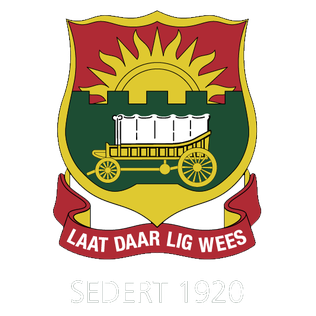
Afrikaanse Hoër Seunskool, is a public Afrikaans medium high school for boys situated in the suburb of Elandspoort in Pretoria in the Gauteng province of South Africa. The school was founded in 1920 by Jan Joubert and reverend Chris Neethling.
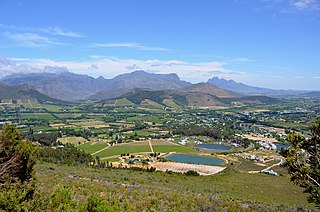
Franschhoek is a small town in the Western Cape Province and one of the oldest towns in South Africa. It was formerly known as Oliphants hoek. It is situated about 75 kilometres (47 mi) from Cape Town, a 45-minute drive away. The whole area, including townships such as Groendal and suburbs such as Wemmershoek, has a population of slightly over 20,000 people while the town proper, known as Hugenote, has a population of around 1,000. Since 2000, it has been incorporated into Stellenbosch Municipality. In 2022, Franschhoek was mentioned in Time magazine as one of the top 50 places in the world to visit.

Grey College is a semi-private English & Afrikaans medium school for boys situated in the suburb of Universitas in Bloemfontein in the Free State province of South Africa, it is one of the 23 Milner Schools. The sister school is Eunice High School (Bloemfontein).
White South Africans generally refers to South African citizens of European descent. In linguistic, cultural, and historical terms, they are generally divided into the Afrikaans-speaking descendants of the Dutch East India Company's original colonists, known as Afrikaners, and the Anglophone descendants of predominantly British colonists of South Africa. In 2016, 57.9% were native Afrikaans speakers, 40.2% were native English speakers, and 1.9% spoke another language as their mother tongue, such as Portuguese, Greek, or German. White South Africans are by far the largest population of White Africans. White was a legally defined racial classification during apartheid.
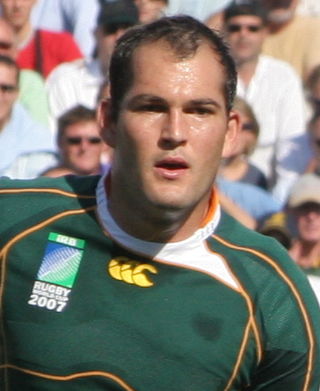
Petrus Fourie du Preez is a South African former professional rugby union player. He played as a scrum half for the Blue Bulls in the Currie Cup competition and the Bulls in Super Rugby between 2002 and 2011, and for Japanese Top League side Suntory Sungoliath between 2011 and 2016. He represented South Africa between 2004 and 2015, winning 76 caps, playing in three Rugby World Cup tournaments, and winning the 2007 competition.

Wynand Olivier is a former South African professional rugby union player.His usual position was at centre.
Paul Roos Gymnasium is a public, dual medium high school for boys in the town of Stellenbosch in the Western Cape province of South Africa, which opened on 1 March 1866 as Stellenbosch Gymnasium. It is the 12th oldest school in the country.

Hoërskool Bellville is a public Afrikaans medium co-educational high school situated in Bellville in the Western Cape province of South Africa, It is one of the top schools in the Western Cape province, It was founded in 1937.
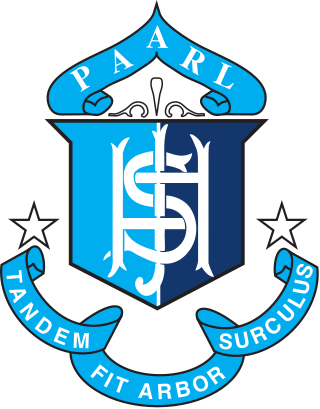
Paarl Boys' High School, known in Afrikaans as Hoër Jongenskool Paarl is one of the oldest schools in South Africa, built in 1868. The school is situated in Paarl, a town in the Western Cape province of South Africa. The first headmaster of the school was George Jeffreys. Effective as of 2007, the headmaster of the school is Derek Swart.
Paarl Gimnasium is a public Afrikaans medium co-educational high school situated in the city of Paarl in the Western Cape province of South Africa.

Afrikaners are a Southern African ethnic group descended from predominantly Dutch settlers first arriving at the Cape of Good Hope in 1652. Until 1994, they dominated South Africa's politics as well as the country's commercial agricultural sector.
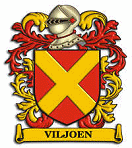
Viljoen is an Afrikaans surname, derived from the French Villion. It was brought to South Africa in 1671 by French Huguenots who subsequently intermarried with the local Dutch population. The progenitors of the extended Viljoen clan are François Villion and Cornelia Campenaar. Married in the Cape of Good Hope, they later farmed for a living near Stellenbosch. Some of their descendants include:

Hoërskool Voortrekker is a public Afrikaans medium co-educational high school situated in the municipality of Boksburg in the city of Ekurhuleni in the Gauteng province of South Africa. The academic school was established in 1920.

Johannes Albertus Munnik Hertzog was a South African politician, Afrikaner nationalist, cabinet minister, and founding leader of the Herstigte Nasionale Party. He was the son of J. B. M. (Barry) Hertzog, a former Prime Minister of the Union of South Africa.
The 2013 Varsity Cup was contested from 4 February to 8 April 2013. The tournament was the sixth season of the Varsity Cup, an annual inter-university rugby union competition featuring eight South African universities.

A team of more than 150 athletes flew the flag for South Africa at the 2015 All-Africa Games in Brazzaville, Republic of the Congo in September. South African athletes competed in a total of 15 different sports against their continental counterparts at the Games which ran 4–19 September while there was also representation by para-athletes in the power-lifting and athletics codes.

The Havenga Prize is a prize awarded annually by the Suid-Afrikaanse Akademie vir Wetenskap en Kuns to a candidate for original research in the Sciences since 1945. Candidates are judged on the quality of research publications and evidence of the promotion of Afrikaans. The Havenga prize can only be awarded to a person once, but can be awarded posthumously.


















